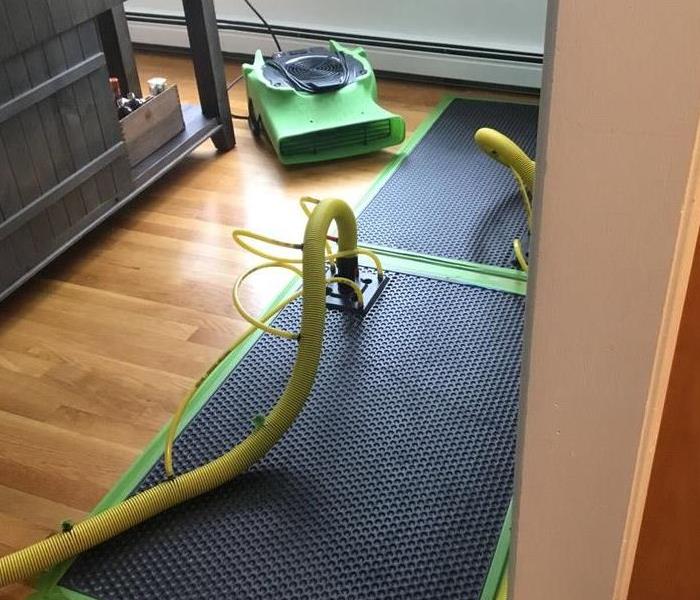How Can I Isolate Some Sections Of My Merrimack House During Water Removal?
8/14/2020 (Permalink)
SERVPRO Is One of the Premier Water Removal Services in Merrimack That Can Help Take Care of All Your Needs in Case of Water Intrusion
Once you discover a water spill at your home, several things run through your mind, including how to stop the source, remove the water, and take care of any necessary repairs. Apart from these routine issues, you might also have unique needs, such as isolating some sections of your Merrimack property during the restoration process.
What reasons could prompt seclusion of some sections in a home?
Water removal exercises in Merrimack are unique at each property and in every incident. The incident at your home may present some unique challenges that prompt you to desire seclusion of some areas. Some typical reasons include:
- Residency purposes
- To prevent the unchecked spread of unwanted materials
- To create a temporary but safe storage section
You may be worried about the implications of staying in a wet house, including the possibility of developing respiratory issues but, at the same time, want to save the cost of seeking alternative accommodation. Safeguarding the sections of the property unaffected by the water spill can ensure you achieve both goals.
Is containment sufficient in safeguarding the desired areas?
Establishing containment around specific areas of the property is an excellent way to achieve the desired seclusion. Our SERVPRO technicians can help you create the right type of containment using suitable materials that create airtight barriers. For instance sealing off openings such as doors or hallways to separate some rooms or sections of the property from the affected areas, thus locking out moisture or debris from spreading, is easier with supplies such as:
- Spring-loaded poles
- 4 or 6-mil plastic sheets
- Zip lock doors
- Painters tape
With these materials, such containment is easy to set up, taking only a few minutes to construct. As one among the leading restoration companies in the area, we reuse most of the materials we use to set up containment in properties, thus spreading the acquisition costs around rather than burdening a single project.
Apart from limiting moisture from spreading, do containments help water removal in any way?
The drying phase of water removal involves accelerating evaporation, among other processes. If such evaporation drives the humidity level in the air too high, materials with hygroscopic properties such as gypsum or upholstery fabrics in unaffected sections of the property can reabsorb the evaporating moisture, thus recreating the problem. Containing the wet areas creates an opportunity to maximize evaporation efforts without the other problems, thus improving the turnaround time of the entire removal process.
Is containment sufficient in limiting water movement?
Once water leaks into a property, it spreads from the original access point in a couple of ways including:
- Surface flow
- Capillary action
- Evaporation
Containment mostly helps stop humidity laden air from circulating all over the property. It might also help prevent some surface flow to a certain degree. Our SERVPRO technicians incorporate other water removal procedures depending on the conditions at your property. For instance, if there are pools on the floors, expediting water extraction is helpful. We have access to sufficient units of water removal equipment, including:
- Portable extraction units
- Deep extraction tools
- Light wands
- Drying mats
Sometimes the source of the spreading moisture is hidden away in a wall or floor cavity. Containment alone is not a viable solution for such a problem. Our technicians find resourceful ways to deal with such moisture reservoirs to ensure the removal of the moisture threat to the entire property. For a non-invasive approach, we use structural cavity drying equipment to remove the moisture. The process only requires drilling small holes at the base of the walls, which can help release any water trapped in the cavity. Later we use the holes as the access points for the cavity drying equipment to direct airflow into the wall cavity. The systems replace the moist cold air trapped in the cavity with warmer dry air, which absorbs more moisture, thus promoting drying.
In the case of water trapped within the floor assembly, we can use drying mats, which help pull water beneath tiles or wooden floorboards. Removal using drying mats is not only practical but also helps avoid irreversible damage that other methods can cause on hard surfaces such as tiles or hardwood. The mats create an airtight seal with the floor surface allowing a high lift extractor to suction the water from the floor through the allocated openings.
When you have unique challenges caused by water spills, SERVPRO of Merrimack is one of the best restoration companies in the area that you can call for assistance. You can reach us at (603) 262-9293 so that we help you deal with any challenge, "Like it never even happened."






 24/7 Emergency Service
24/7 Emergency Service